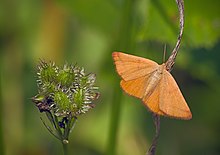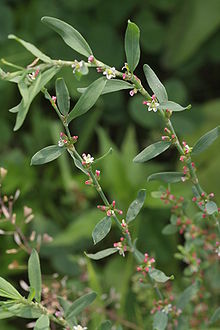Knotweed purple spider
| Knotweed purple spider | ||||||||||||
|---|---|---|---|---|---|---|---|---|---|---|---|---|

Knotweed purple flyer ( Lythria purpuraria ), |
||||||||||||
| Systematics | ||||||||||||
|
||||||||||||
| Scientific name | ||||||||||||
| Lythria purpuraria | ||||||||||||
| ( Linnaeus , 1758) |
The knotweed purple spanner ( Lythria purpuraria ), also known as knotweed purple spider or bird knotweed purple spanner , is a butterfly ( moth ) from the spanner family (Geometridae). The specific epithet is based on the Latin word purpura meaning "purple" and refers to the color of the moths. In English usage it is referred to as purple-barred yellow .
features
butterfly
The moths usually reach a wingspan of 20 to 26 millimeters. Occasionally there are also butterflies with a minimum wingspan of 18 or a maximum of 28 millimeters. On the ocher-yellow, yellow-brown or greenish-yellow upper side of the forewings, two narrow purple-red bands stand out, which usually do not reach the inner edge . A red point can sometimes be seen on the front edge between the two bands. The intensity of the coloring varies considerably depending on the geographical occurrence or the season of the occurrence. The upper side of the hind wings is yellow to yellow-orange without drawing. The proboscis is weak. The antennae of the males are provided with long comb teeth on both sides, those of the females are thread-shaped.
egg
The egg has a white-yellow to greenish-yellow color, an elongated oval shape and is about twice as long as it is wide. It is flattened at the ends and covered with an irregular polygonal network structure and small depressions.
Caterpillar
Adult caterpillars are very slender and reddish brown to dark brown in color. The back line is light brown to white-gray, the side stripes are light yellow-brown, the belly is whitish. Three light vertical stripes and two buttons stand out clearly on the brownish head.
Doll
The cream-colored pupa has a dark gray-brown piebald and shows olive-green wing sheaths, whose light gray-yellow veins shine through. The spiracles are black. The cremaster is dark brown in color, slightly wavy and bulging. There are eight chitin hooks of different lengths on the round, wide, flattened tip.
Similar species
- When lythria cruentaria ( lythria cruentaria ) the wings are shorter and rounder, the purple-Top are usually much wider than in lythria purpuraria .
- Lythria sanguinaria shows near the edge on the fore wing upper side a third, sometimes broken up purple transverse band.
- Lythria plumularia is distinguished by the flat purple-brown color at the base of the fore and hind wings and the overall darker appearance.
Distribution and occurrence
The species is distributed all over southern, central and eastern Europe and Asia Minor , but is absent in Fennoscandinavia and the British Isles . Its area extends from the Baltic States to the east as far as Siberia and northwest China .
The knotweed purple spider populates primarily lean and sandy areas, grassy heaths, stubble fields, fallow land, wastelands and warm, stony slopes. In the Southern Alps it was found at an altitude of 1200 meters.
Way of life
The diurnal moths fly fast over the vegetation in the sunshine, preferably in the afternoon. They appear in two generations from late April to early June and from mid-June to early September. The caterpillars are monophagous and feed on the flowers and seeds of the bird knotweed ( Polygonum aviculare ). A development time of four to five weeks was found in breeding. The pupae of the summer generation overwinter.
Danger
The knotweed purple moth occurs in Germany in very different population densities in the individual federal states, has disappeared in some northern and western regions and is therefore classified differently on the Red List of endangered species depending on the region. In Baden-Württemberg , Bavaria , Rhineland-Palatinate , Lower Saxony and Thuringia it is “critically endangered”, in Brandenburg and Saxony-Anhalt “very endangered”.
Individual evidence
- ^ Arnold Spuler: The butterflies of Europe , Volume 2, E. Schweizerbart'sche Verlagsbuchhandlung, Stuttgart, 1910, p. 30
- ^ Axel Hausmann, Jaan Viidalepp: The Geometrid Moths of Europe . In: Axel Hausmann (Ed.): The Geometrid Moths of Europe . 1st edition. Volume 3: Larentiinae II . Apollo Books, Stenstrup 2012, ISBN 978-87-88757-39-2 (English). , Pp. 24-26
- ↑ Walter Forster, Theodor A. Wohlfahrt: The butterflies of Central Europe. Volume 5: Spanner. (Geometridae). Franckh'sche Verlagshandlung, Stuttgart 1981, ISBN 3-440-04951-5 , pp. 56-58.
- ↑ Ernst Urbahn: Contributions to the determination of difficult to distinguish butterfly species., Part 11. Lythria purpuraria L., purpurata L. and plumularia FRR. (Lep. Geom.) , International Entomological Journal, No. 29, 1910, pp. 325-329 and 337-343
- ^ A b Günter Ebert (Hrsg.): The butterflies of Baden-Württemberg Volume 8, Nachtfalter VI (Spanner (Geometridae) 1st part), Ulmer Verlag Stuttgart 2001. ISBN 3-800-13497-7 , pp. 212-215
- ^ Josef Wolfsberger: The Macrolepidoptera fauna of the Lake Garda area. 6. Contribution to the knowledge of the Lepidoptera fauna of the Southern Alps. , Museo Civico di Storia Naturale, Verona, 1966
- ↑ Ernst and Herta Urbahn: The butterflies of Pomerania with a comparative overview of the Baltic Sea region , Entomological Association of Stettin, Stettin 1939
- ^ F. Heydemann: Contribution to the knowledge of Lythria purpuraria L. and L. purpurata L. (Lep. Geom.) , Entomologische Zeitschrift, Frankfurt a. M., No. 50, 1936, pp. 159-164, 173-176, 185-188
- ↑ Manfred Koch , Wolfgang Heinicke, Bernd Müller: We determine butterflies. Volume 4: Spanner. 2nd, improved and enlarged edition. Neumann, Leipzig / Radebeul 1976, DNB 780451570 , pp. 82-83.
- ↑ Endangerment
literature
- Axel Hausmann, Jaan Viidalepp: The Geometrid Moths of Europe . In: Axel Hausmann (Ed.): The Geometrid Moths of Europe . 1st edition. Volume 3: Larentiinae II . Apollo Books, Stenstrup 2012, ISBN 978-87-88757-39-2 (English).
- Walter Forster , Theodor A. Wohlfahrt : The butterflies of Central Europe. Volume 5: Spanner. (Geometridae). Franckh'sche Verlagshandlung, Stuttgart 1981, ISBN 3-440-04951-5 .
- Günter Ebert (Hrsg.): The butterflies of Baden-Württemberg Volume 8, Nachtfalter VI (Spanner (Geometridae) 1st part), Ulmer Verlag Stuttgart 2001. ISBN 3-800-13497-7
- Arno Bergmann: The large butterflies of Central Germany. Volume 5/1: Spanner. Distribution, forms and communities. Urania-Verlag, Jena 1955, DNB 450378403 .
Web links
- Lepiforum e. V. - Taxonomy and photos
- pyrgus.de - Butterflies and their ecology
- euroleps.ch - Euroleps (imago, egg, caterpillar, doll)
- www.leps.it - Butterflies and Moths of Europe and North Africa
- ukmoths.org.uk - UKMoths
- fauna-eu.org - Fauna Europaea


